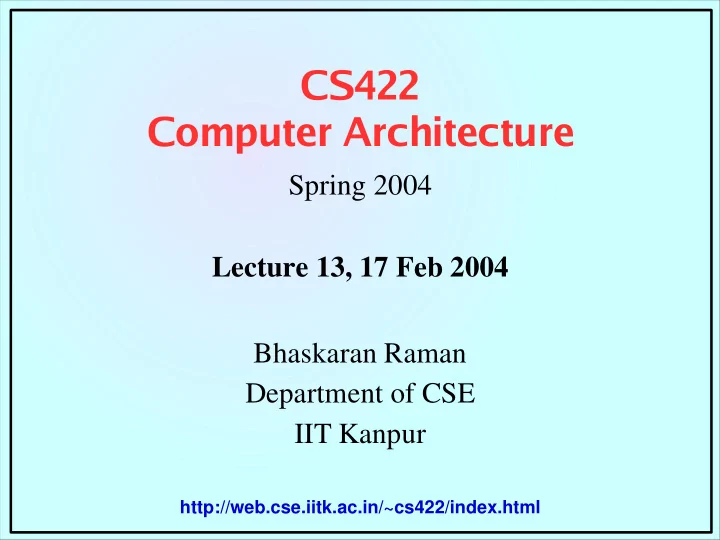

CS422 Computer Architecture Spring 2004 Lecture 13, 17 Feb 2004 Bhaskaran Raman Department of CSE IIT Kanpur http://web.cse.iitk.ac.in/~cs422/index.html
Dynamic Scheduling ● Better than static scheduling ● Scoreboarding: – Used by the CDC 6600 – Useful only within basic block – WAW and WAR stalls ● Tomasulo algorithm: – Used in IBM 360/91 for the FP unit – Main additional feature: register renaming to avoid WAR and WAW stalls
Register Renaming: Basic Idea ● Compiler maps memory --> registers statically ● Register renaming maps registers --> virtual registers in hardware, dynamically ● Should keep track of this mapping – Make sure to read the current value ● Num. virtual registers > Num. ISA registers usually ● Virtual registers are known as reservation stations in the IBM 360/91
Tomasulo: Main Architectural Features ● Reservation stations: fetch and buffer operand as soon as it is available ● Load/store buffers: have the address (and data for store) to be loaded/stored ● Distributed hazard detection and execution control ● Common Data Bus (CDB): results passed from where generated to where needed ● Note: IBM 360/91 also had reg-mem instns.
The Tomasulo Architecture From instn. unit From mem. FP Regs Load Buffers FP Opn Queue Opn. Bus Store Buffers Opnd. Bus To mem. Resvn. Stns. Resvn. Stns. FP MUL/DIV FP ADD/SUB Common Data Bus
Pipeline Stages ● Issue: – Wait for free Reservation Station (RS) or load/store buffer, and place instruction there – Rename registers in the process (WAR and WAW handled here) ● Execute (EX): – Monitor CDB for required operand – Checks for RAW hazard in this process ● Write Result (WB): – Write to CDB – Picked up by any RS, store buffer, or register
Register Renaming ● In RS, operands referred to by a tag (if operand not already in a register) ● The tag refers to the RS (which contains the instruction) which will produce the required operand ● Thus each RS acts as a virtual register
The Data Structure ● Three parts, like in the scoreboard: – Instruction status – Reservation stations, Load/Store buffers, Register file – Register status: which unit is going to produce the register value ● This is the register --> virtual register mapping
Components of RS, Reg. File, Load/Store Buffers ● Each RS has: – Op: the operation (+, -, x, /) – Vj, Vk: the operands (if available) – Qj, Qk: the RS tag producing Vj/Vk (0 if Vj/Vk known) – Busy: is RS busy? ● Each reg. in reg. file and store buffer has: – Qi: tag of RS whose result should go to the reg. or the mem. locn. (blank ==> no such active RS) ● Load and store buffers have: – Busy field, store buffer has value V to be stored
Maintaining the Data Structure ● Issue: – Wait until: RS or buffer empty – Updates: Qj, Qk, Vj, Vk, Busy of RS/buffer; Maintain register mapping (register status) ● Execute: – Wait until: Qj=0 and Qk=0 (operands available) ● Write result: – CDB result picked up by RS (update Qj, Qk, Vj, Vk), store buffers (update Qi, V), register file (update register status) – Update Busy of the RS which finished
Some Examples ● Randy Katz's CS252 slides... (Lecture 11, Spring 1996) ● Dynamic loop unrolling example from text
Dynamic Loop Unrolling Loop: LD F0, 0(R1) // F0 is array element ADDD F4, F0, F2// F2 has the scalar 'C' SD 0(R1), F4 // Stored result SUBI R1, R1, 8 // For next iteration BNEZ R1, Loop // More iterations? ● Assume branch predicted to be taken ● Denote: load buffers as L1, L2..., ADDD RSs as A1, A2... ● First loop: F0 --> L1, F4 --> A1 ● Second loop: F0 --> L2, F4 --> A2
Summary Remarks ● Memory disambiguation required ● Drawbacks of Tomasulo: – Large amount of hardware – Complex control logic – CDB is performance bottleneck ● But: – Required if designing for an old ISA – Multiple issue ==> register renaming and dynamic scheduling required ● Next class: branch prediction
Recommend
More recommend